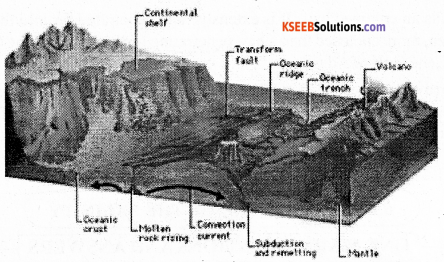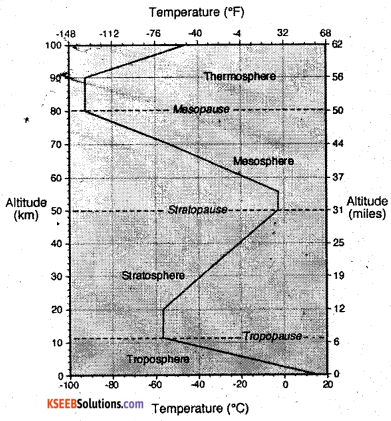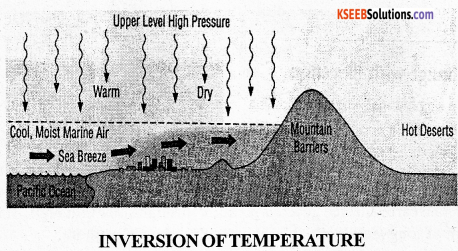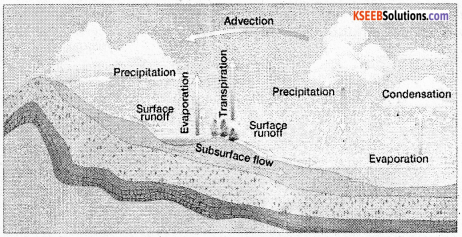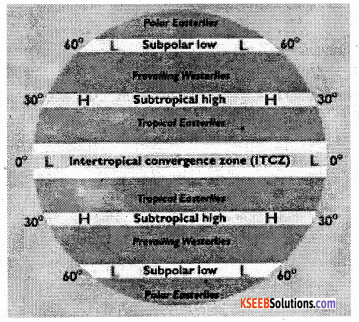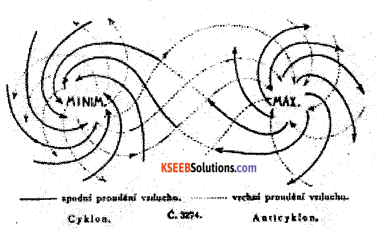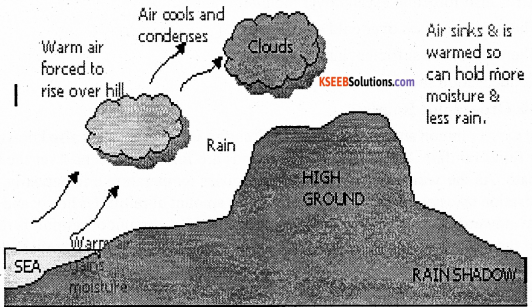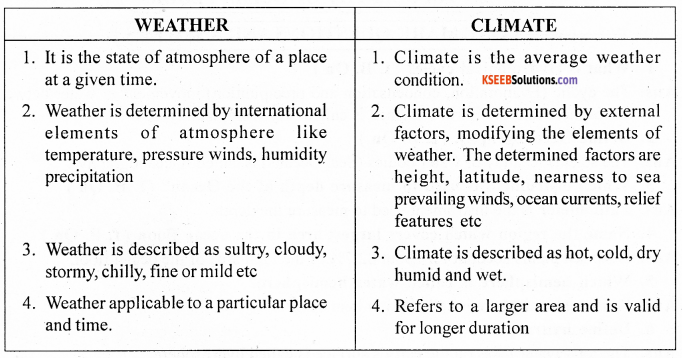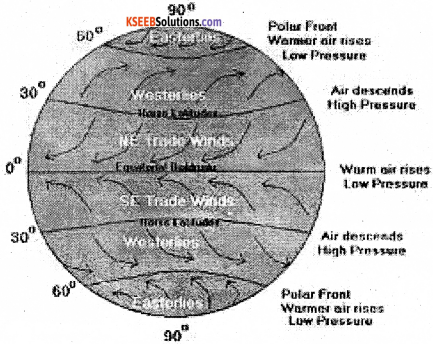Karnataka 1st PUC Geography Question Bank Chapter 7 Biosphere
You can Download Chapter 7 Biosphere Questions and Answers, Notes, 1st PUC Geography Question Bank with Answers Karnataka State Board Solutions help you to revise complete Syllabus and score more marks in your examinations.
1st PUC Geography Biosphere One Mark Questions and Answers
Question 1.
Why the Earth is called “Living Planet”?(T.B.Qn)
Answer:
Earth is called Living Planet because it is the home of various forms of life.
Question 2.
What is Environment? (T.B.Qn)
Answer:
The whole sum of surrounding external conditions within which an organism, a community or an object exists is called ‘Environment.
Question 3.
Which day is celebrated on 5th June?
Answer:
World Environmental day.
![]()
Question 4.
What is deforestation?
Answer:
It refers to removal or destruction of the forest cover of an area.
Question 5.
What is Photo synthesis?
Answer:
The conversion of water and carbon dioxide by plants into glucose and oxygen light is used as an energy source.
Question 6.
Define Ecology. (T.B.Qn)
Answer:
Ecology is the science of the relationship between living organism and their Surroundings.
![]()
Question 7.
Who used the term of ‘Eco system’ in the First time?
Answer:
A.GTransley in 1935
Question 8.
Where the Earth summit was held ?
Answer:
Rio-de-janerio
Question 9.
What do you mean by Species?
Answer:
A category used in the classification of organisms that consist of a group of individuals that can breed among themselves and produce offspring.
![]()
Question 10.
What is food chain?
Answer:
Food chain is an idealized pattern of flow of energy in a natural eco system.
Question 11.
Who used the term Ecology in first time?
Answer:
The term Ecology was introduced by Ernest Hackel ini 869.
Question 12.
What is Biomes? (T.B.Qn)
Answer:
A distinct group of life forms and the environment in which they are found is called Biomes.
![]()
Question 13.
Mention the components of Ecosystem?
Answer:
Biotic and Aboitic components
Question 14.
What is Tundra biome?
Answer:
It refers to small plants that can grow quickly during a short warm to cool summer season, in the low temperature and high latitudinal areas.
Question 15.
What are Heterotrophic?
Answer:
These organisms are dependent upon other organisms for food. It consists of consumers and decomposers.
Question 16.
What is deforestation?
Answer:
It refers to removal or destruction of the forest cover of an area.
![]()
Question 17.
What is Biomagnifications?
Answer:
The phenomenon by which toxic chemical get concentrated with the increasing tropic levels is known as biomagnifications.
Question 18.
Define the term Biodiversity. (T.B.Q)
Answer:
The varied range of flora and fauna found within a specified geographic region is called ‘Biodiversity’:
Question 19.
What are Hot spots of bio diversity?
Answer:
Areas rich I species diversity are called the Hot spots of biodiversity.
![]()
Question 20.
Define Species.
Answer:
A group subordinate to a genus and containing individuals agreeing in some common attributes and called by a common names.
Question 21.
Define Endemic species.
Answer:
Endemism is the ecological state of being unique to a particular geographic location such as a specific island, habitat type or nation.
![]()
1st PUC Geography Biosphere Two Marks Questions and Answers
Question 1.
Mention the types of Environment. (T.B.Qn)
Answer:
Physical Environment and Cultural Environment.
Question 2.
What is Physical Environment? (T.B.Qn)
Answer:
The environment which is created or formed naturally with biotic things is called physical environment. Land, water, soil, rainfall, winds and biological features on the earth are the factors of physical environment.
![]()
Question 3.
What is biotic component? (T.B.Qn)
Answer:
Biotic component are the living component consist of various plants, animals and microbes comprising many different interdependent populations.
Question 4.
What are Autotrophs? (T.B.Qn)
Answer:
The self producers of food in the ecosystem are together known as the autotrophic component. They produced food with the Photosynthesis process.
Question 5.
What are the components of Biosphere(T.B.Qn)
Answer:
Natural landscape water, soil, temperature, pressure, wind, precipitation are the components of Biosphere.
![]()
Question 6.
What is ‘Ecological Balance’? (T.B.Qn)
Answer:
It refers to the proper balance between the different organisms and their physical environment in the biosphere.
Question 7.
Mention any four types of biomes. (T.B.Q)
Answer:
Major types of biomes are
- Forest biome
- Savanna biome
- Grassland biome
- Desert biome
![]()
Question 8.
What is Aquatic biome?
Answer:
Aquatic regions house numerous species of plants and animals, both large and small. This is where life began billions of years ago. Without water, most life forms would be unable to sustain themselves and the Earth would be a barren, desert-like place. Ponds, lakes, rivers, wetlands and oceans are sources of aquatic biomes.
Question 9.
What is fresh water ecosystem?
Answer:
Fresh water ecosystems may have flowing water (lotic) and standing water (lentic). Lotic refers to running fresh water and ecosystem includes streams and rivers. Lintec includes ponds, lakes, swamps, etc.
![]()
Question 10.
What are natural cycles?
Answer:
The ecological balance in a ecosystem is maintained through innumerable natural cycles. The cyclic processes are similar to food chain or nutrient cycle through which energy flows. Important natural cycles are carbon cycle, nitrogen cycle, oxygen cycle, hydrogen cycle and hydrological cycle.
Question 11.
What is Biogeochemical Cycle?
Answer:
The cyclic movement of elements of the biosphere between living organism (the biotic phase) and their non-living (a biotic) surroundings (e.g. rocks, water, air etc.) is termed, ‘biogcochemical Cycle.
![]()
Question 12.
What is Nitrogen cycle?
Answer:
It is an important constituent of tissues of living organisms and its primary reservoir is atmosphere. Main processes involved in the nitrogen cycle are biological and chemical fixation of nitrogen, denitrification, etc.
Question 13.
State the features of Genetic biodiversity. (T.B.Q)
Answer:
It refers to the variation of genes within the species and variation of individual organisms having certain similarities in their physical characteristics called species. Human beings genetically belong to the homo-sapiens group and also differ in their characteristics such as height, color, hair, physical appearance etc.
![]()
Question 14.
Mention the major aspects of Bio-diversity.
Answer:
The distribution of different kinds of ecosystem b. The total number of species in a region c. The number of endemic species in an area d. The genetic diversity in an individual species 5. The sub-population of an individual species which embrace the genetic diversity.
Question 15.
What are the causes for the loss of biodiversity?
Answer:
Many activities of man have resulted in the Biodiversity loss.
- The habitat of plants and animals has been altered due to human interference. As the plants and animals could not adapt to the changed circumstances have been facing extinct.
- Large areas of forests have been removed for agricultural land, road and railway line construction and also for the construction of dam etc.
![]()
Question 16.
Explain biotic components and its type?
Answer:
Biotic components consist of plants, animals and micro-organism. It is of two types. One is autotrophic which comprises of those plants which produce food for themselves through photosynthesis. They are called as primary producers and the other is Heterotrophic, comprises of those plants which produce food for themselves through photosynthesis. They are called as primary producers and the other is heterotrophic, comprises of those organism which depend on Autographs.
1st PUC Geography Biosphere Five Marks Questions and Answers
Question 1.
Explain the causes and measurers for ecological imbalance.
Answer:
Ecological imbalance refers to a situation where the changes in the environment exceed the capacity of the ecosystem to with stand the environmental changes.
a. Deforestation: Man clears the forests in Mountain regions to grow food and to build houses for himself. This reckless deforestation in hilly regions is one of the main causes of ecological imbalance.
b. Over grazing: Over grazing is another important cause for ecological imbalance.
c. Extensive use of ground water: man ahs evolved irrigation system to assume a continuous supply of water for agriculture. He has topped not only the surface water, but also the underground water in his greed to get more irrigation facilities; he has made extensive use of ground water. The extensive use of ground water is responsible for ecological imbalance.
d. Destruction of animals: Destruction of numerous species of animals also contributes to ecological imbalances.
e. Air and Water pollution: Air and water pollution caused by industrial effluent, sewage water, garbage etc., especially in urban areas, creates ecological imbalance. Measures for ecological imbalances: For the maintenance of ecological balance, the following measures may be taken:
- Avoidance of reckless deforestation and overgrazing.
- Control of soil erosion
- Proper use of ground water resources
- Controlled irrigation
- Preservation of wild life
- Control of air and water pollution
- Check on population explosion.
![]()
Question 2.
Briefly explain the Biomes. (T.B.Q)
Answer:
A distinct group of life forms and the environment in which they are found is called ‘Biomes’. In other words, Biome is a plant and animal community that covers a large geographical area. On the basis of the dominant life form, six major biomes are identified.
a. Forest biomes: Trees are the dominant life form of forest biome. High temperature, humid climate and soil moisture help for thick tree cover. Equatorial region is dominant with forest biome.
b. Savanna biome: It is the transitional biome between the forest biome and grassland biome. Savanna biome comprises of trees with grasses and herbs. It occupies areas of low and seasonal rainfall.
c. Grassland biome: in this biome grasses constitute the dominant vegetation. It is dominant in the moderate soil water deficit regions, semi-arid areas of dry tropical, sub-tropical and mid-latitude regions.
d. Desert biome: It includes organisms capable of surviving in moderate to severe water deficit for most of the year. In this region temperature may range from hot to cool. Most common plants found in this belt are xerophytes.
e. Tundra biome: It includes small plants that can grow quickly during a short warm to cool summer season, in the low temperature and high latitudinal areas.
f. Aquatic biome: Aquatic regions house numerous species of plants and animals, both large and small. This is where life began billions of years ago. Without water, most life forms would be unable to sustain themselves and the Earth would be a barren, desert-like place. Ponds, lakes, rivers, wetlands and oceans are sources of aquatic biomes.
![]()
Question 3.
Describe the main aspects and three levels of study of Biodiversity. (T.B.Q)
Answer:
The varied range of flora and fauna found within a specified geographic region is called ‘Biodiversity’. The study of biodiversity is deals at three levels.
a. Genetic diversity: Genes are the basis building blocks of various life forms. Genetic biodiversity refers to the variation of genes within the species. It refers to the variation of individual organisms having certain similarities in their physical characteristics called species. This genetic diversity is essential for a healthy breeding of population species.
b. Specific Diversity: The species diversity refers to the variety of species. It relates to the number of species in a defined area and it is measured through its richness, abundance and types. Some areas are more rich in species than others.’
c. Eco system Diversity: Broad differences between ecosystem types and the diversity of habitats and ecological processes occurring within each ecosystem constitute eco system diversity.
![]()
Question 4.
What is Biodiversity? Explain the types and conservation of bio-diversity?
Answer:
Bio-diversity means the diversity of variety of world’s living organism. In other words, the variety of species both flora and fauna present in an area is known as “bio-diversity”. According to the world resource institute: bio-diversity is a variety of the world’s organism’s including their genetic diversity and the assemblage they form.
The earth is endowed with a rich variety of living organisms. About 3,50,000 species of plants and 30, 00,000 species of animals have been identified so fat. India is one of the twelve countries of the world very rich in bio-diversity. India has about 46,000piant species and 81,000 animal species.
Types of Bio-diversity: Bio-diversity can be classified into there types. They are :
Genetic diversity, Species diversity and Eco-system diversity.
a. Genetic diversity: Genetic diversity refers to the variety of genes present in the members of species. This is basic level.
b. Species diversity: Species diversity refers to the variety of species in a specific place or among a specific group of organisms. This is the most familiar type and is found in the tropical zone that in cooler areas. India is rich in bio-diversity/. This is due to its tropical location, varied relief features and climate.
c. Eco-system diversity: Eco-system diversity refers to the variety of geographical situations on the earth such as lakes, forests, deserts etc, and the number of plants and animals found in each. Each type of ecosystem has a variety of species that differ from each other.
Conservation of bio-diversity: As loss of biodiversity is not desirable, there should be conservation of biodiversity. Effort should be made to maintain biodiversity.
The following steps may be taken for preserving biodiversity:
- The biological diversity should be identified and monitored.
- There should be the development of national strategies and programs for conserving biological diversity.
- National parks and sanctuaries must be developed for the protection and maintenance of plants and animals.
- Botanical gardens should be developed for the developed for the development and maintenance of new species of flower and other plants.
- Zoos should be developed for the protection and development of rare and new animal species.
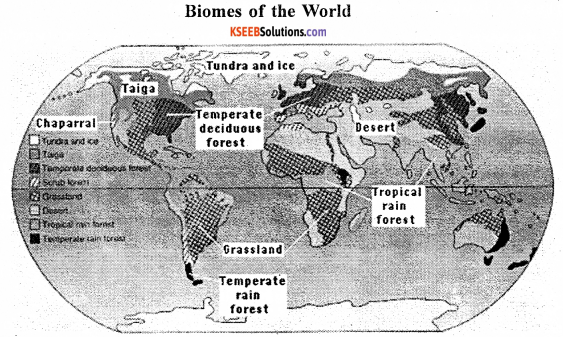
![]()






